-
Posts
1,155 -
Joined
-
Last visited
-
Days Won
1
Content Type
Profiles
Forums
Blogs
Gallery
Events
Store
Posts posted by RobW
-
-
To all,
In both editions of the late Mr Alexander Laslo's book on victory medals 'The Interallied Victory Medals of World War 1 (Ed 1, 1986) (Ed 2, 1992) reference is made to a French reproduction of the Portugal vic.
The details provided in those references are:
Portugal-Reproduction Type 2
* Has 'BRONZE' and 'MADE IN FRANCE' impressed on the rim.
* Unknown diameter.
* Attached to a ball suspender.
There is no illustration in either book of this variety. The only difference in the listing of this variety between the two editions is that in Edition 1 the item is marked as 'Unconfirmed' whereas in Edition 2 this clarifying remark has been removed. The removal of this clarifying remark could lead me to the conclusion that the reproduction type 2 was unconfirmed at the time of the first Edition being released (1986) but confirmation of the existence of the variety was completed by the time the second Edition was published (1992).
In the never-ending research quest I am trying to resolve some of these information gaps and would appreciate any help from the collecting group.
My question is:
"Has anybody ever seen such a variety, or have an example in their collection?" If any collector has such an example it would be appreciated if you could confirm or clarify the existence of this variety, or post a pic for reference.
Regards,
Rob
0 -
Waiting on this one. Supposed to be Arthur Betrand, but the mark dosen't look like his from the PIC. Have to wait to see it in-hand.
Tim
Hey Tim,
When this one arrives, could you post a close-up of the possible Arthus Bertrand mark. I am doing some related French mint mark research and it would be helpful to compare the possible differences and similarities.
Regards,
Rob
0 -
To all,
Here is a pic of a French produced Belgian vic.
The strike is the same as the Belgian produced version with the only readily identifiable difference being the ever so slightly larger ball suspender. It is also generally seen with the French produced vic ribbon which is significantly different to that made in Belgium.
In addition to these differences the French reproduction type is clearly marked on the rim with the word 'BRONZE' as well as a triangle shaped mint mark.
While the major French medal manufacturers at the time produced strikes of quite a few of the vic series, the Belgian one is not often seen in the first place and is becoming harder to obtain.
Regards,
Rob
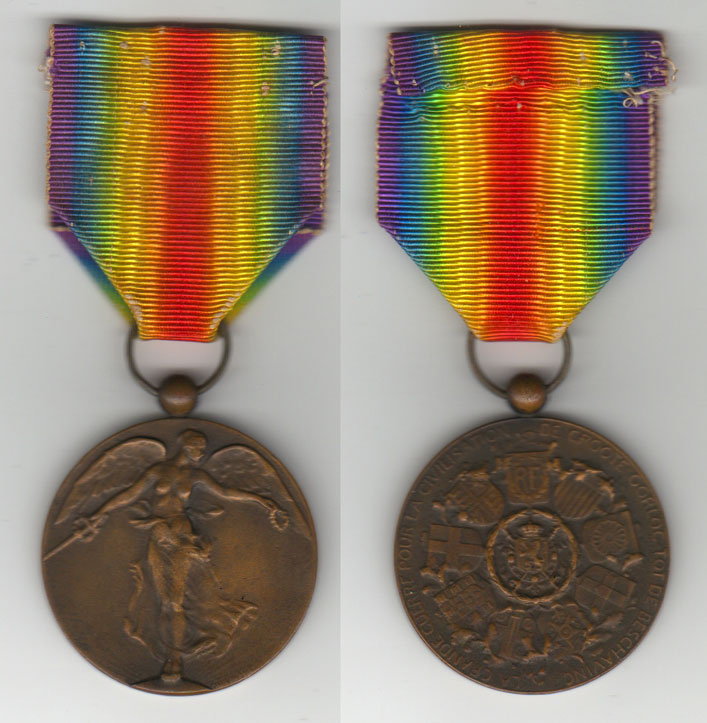 0
0 -
Here are the date bars in close-up.
There are numerous different styles to the date bars with slightly different backstraps.
Regards, Rob
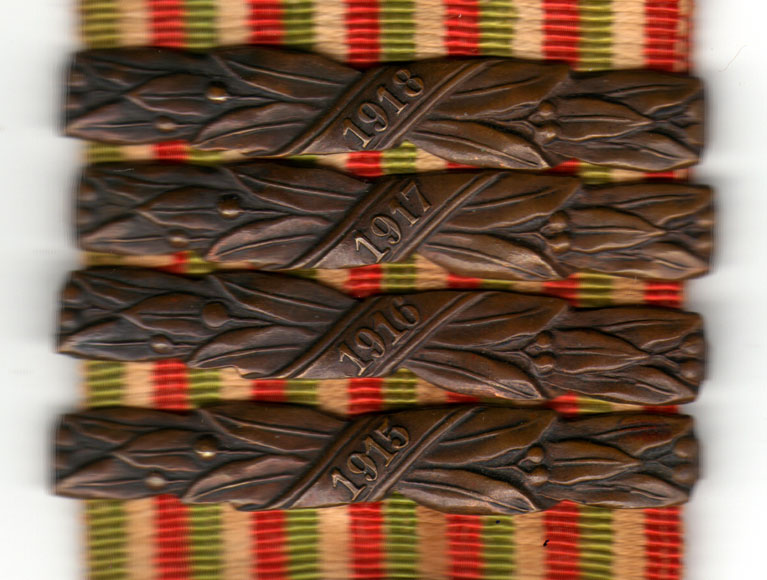 0
0 -
To all,
Here is a nice example of an Italian War Commemorative Medal with all 4 date bars. It is produced in a shiny bronze finish and has the makers mark of 'M. Nelli Inc' of Florence, underneath the bottom of the bust of King Vittorio Emanuele III.
Note the safety pin through the top of the ribbon. This was used to secure the medal to the Ministry of War (Army) award certificate.
Close-ups of the date bars to follow.
Regards, Rob
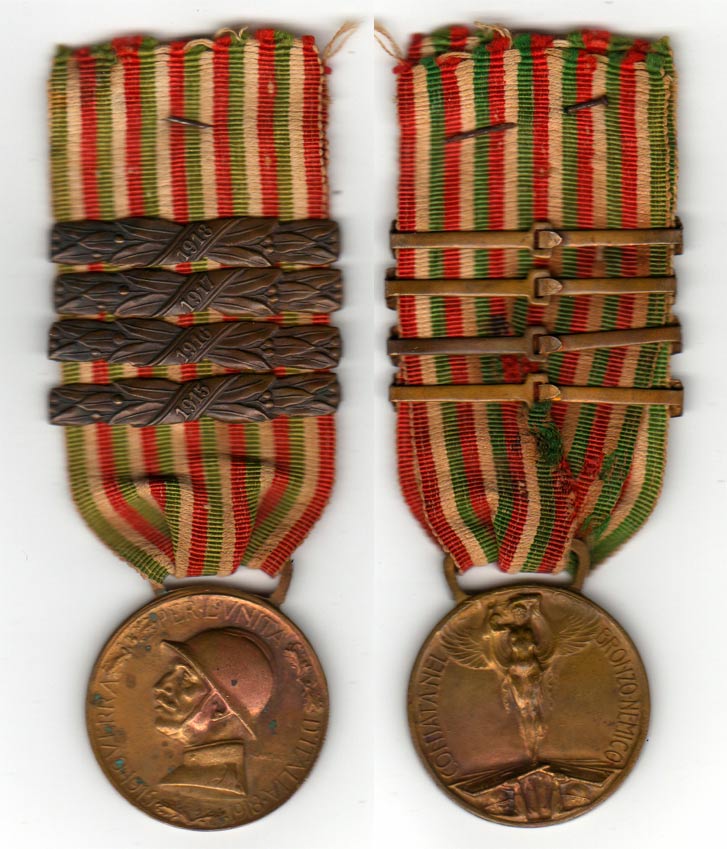 0
0 -
And here is the close-up of the J+B mint mark.
Regards, Rob
 0
0 -
Hello Tim,
While I can't profer any further information on how to accurately date these awards, here is another version of the Combatant Cross produced by Janvier-Berchot. It seems to be a more defined strike than the previously illustrated example from the Paris Mint and it has the triangle JB mint mark on the reverse of the lower arm.
Close-up of the mint mark to follow.
Regards, Rob
 0
0 -
And finally not the medal but British WW1 trio ribbon bar with the prototype Allied Victory Medal ribbon
 (sorry if its not the right place to post it)
(sorry if its not the right place to post it)As an aide to others, and as an addition to Noor's posting, here is another British Great War trio with the prototype vic ribbon.
It is in a bit better shape so the colours can be more clearly identified.
Regards,
Rob
 0
0 -
Did you try the OMSA ribbon bank?
No luck with the OMSA so the search continues...
Regards,
Rob
0 -
Hi Rob,
Nice DSC ribbon bar group. It's interesting to note that the UN Korea Service Medal ribbon is of US manufacture - note the corded edges on the ribbon.
Jean-Paul
Hello Jean-Paul,
I hadn't actually noticed the difference in UN ribbon and it is of a different weave than that seen on the corresponding Australian 7 group on the post above (#4). I do agree that it is indeed a fine ribbon bar. As mentioned to Mervyn the ribbon weaving is of a very fine quality and considerably much better than the replacement ribbon that is seen in the market today.
Regards,
Rob
0 -
Hi - Rob. Very interesting to see these bars with an Aust. and NZ connection. We don't seem to see as much as we should from Aust..
The last ones with the DSC - I bet you wish you had the original set ?
Hello Mervyn,
While there is always a large amount of British items on this forum the Australian and New Zealand items are much more rarely seen. I'm not sure why. I will always try to add such pieces as I come across them to add to the commonwealth flavour.
Yes it is indeed a nice set. The original ribbons are of a markedly better weave than the current production and the rosette on the Burma star is silver, hence the nice deep toning to it. I have also seen the reduced miniature ribbons on a similar ribbon bar arrangement but was not able to obtain that piece.
I can only imagine what the original medals would sell for in todays market.
Regards,
Rob
0 -
A nice New Zealand Navy group of 8:
* Distinguished Service Cross.
* 1939-45 Star.
* Burma Star (with silver rosette denoting Pacific bar).
* Defence Medal.
* British War Medal 1939-45.
* New Zealand Service Medal 1939-45.
* Korea Medal 1950-53.
* United Nations Korea Service Medal 1950-54.
Regards,
Rob
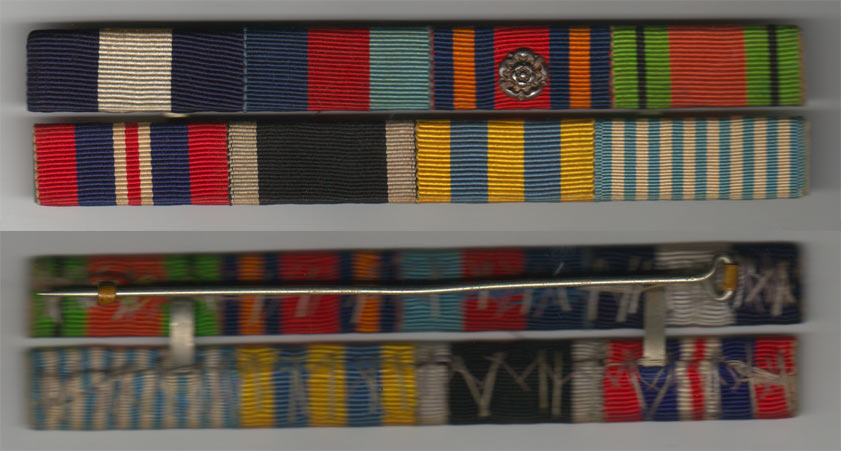 0
0 -
Group of 7:
* 1939-45 Star.
* Africa Star.
* Pacific Star.
* Defence Medal (Service in the Northern Territory of Australia, or the Middle East, east of the Suez Canal, or Malaya prior to 8 December 1941).
* British War Medal 1939-45.
* Australia Service Medal 1939-45.
* United Nations Korea Service Medal 1950-54. (This could be issued for service in the area post-armistice 1953 period or if attached to the UN).
Interestingly the ribbon bar screws are actually screwed threads with triangle shaped attachments.
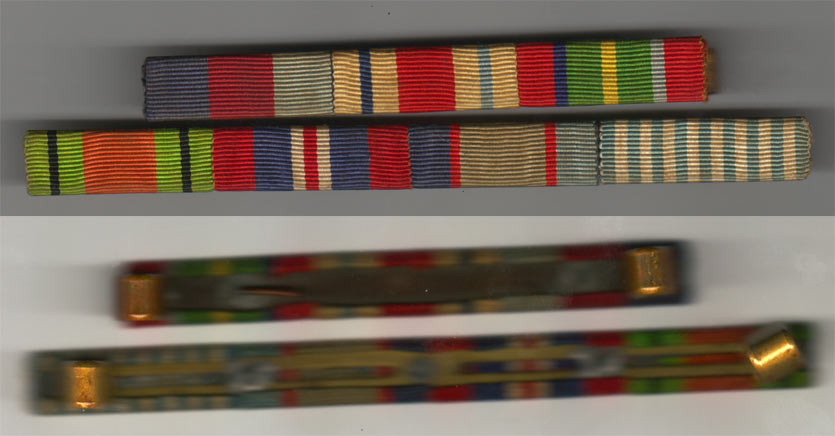 0
0 -
A group of 4:
* 1939-45 Star.
* Pacific Star.
* British War Medal 1939-45.
* Australia Service Medal 1939-45.
This ribbon bar group is regularly seen and indicates an Australian serviceman who served in the Pacific theatre of war.
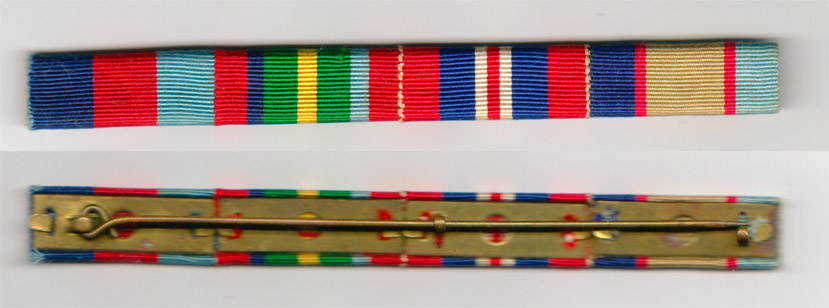 0
0 -
A trio of:
* British War Medal 1939-45.
* Australia Service Medal 1939-45.
* Efficiency Medal.
This group indicates both pre-war reserve or territorial service as well as home service inside Australia during the war.
 0
0 -
To all,
As there doesn't appear to be a lot of ribbon bars from the antipodes on the forums here are a couple of ribbon bars from Australia and New Zealand.
Descriptions and explanations will be posted with the pics.
The first of 5 ribbon bars.
A pair of:
*British War Medal 1939-45.
*Australia Service Medal 1939-45.
This pair indicates home service in Australia only and no operational service outside of Australia.
More to follow.
Regards,
Rob
 0
0 -
Here is few extra Victory medals related items, what I have in my humble collection...
British Victory Medal - G-1834 PTE D MC CORMACK R. IR.FUS..
Bilingual - BURG.P.J.SENEKAL SHUTERLAND KDO.
Hello Noor,
Nice pics. Any humble collection has to start somewhere. That is the interesting thing about the vic series; there is always something to collect considering the large number of countries involved and the corresponding number of different strikes and varieties.
The bonus of vics from the Commonwealth countries (Great Britain, Australia, Canada, New Zealand, India, South Africa) was that the medals were named which makes researching them all the more enjoyable.
Regards,
Rob
0 -
To all,
To change direction a little, here is a Portugal unofficial type 2 vic. In Mr Laslo's reference book it is described as the 'cracked die' variety.
Note the cracks in the obverse design running from approximately the 5 o'clock position (as viewed) through the legs of victory and running upwards toward and parallel to the left hand and wing of victory. These cracks end at around the 10 o'clock position.
The planchet is quite thin.
Regards,
Rob
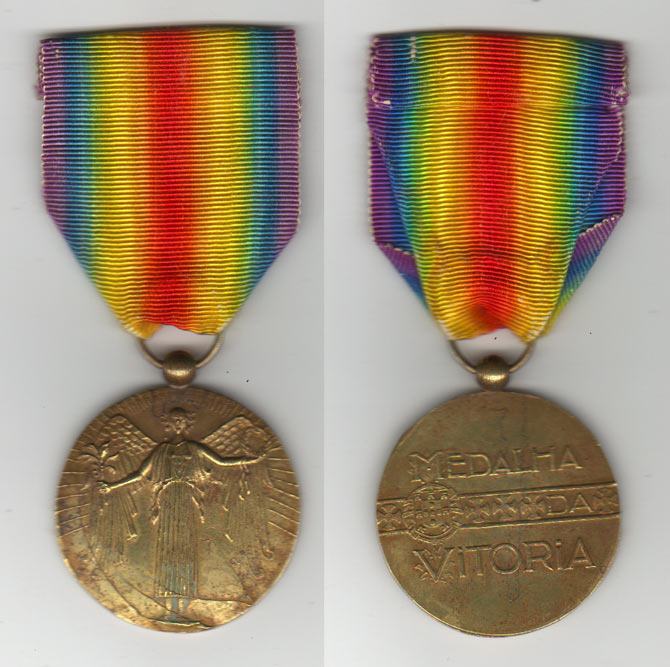 0
0 -
Question:
Did the US Navy issue a France clasp for WW1 US Victory medal? I noticed an Aviation clasp along with a France clasp on a WW1US Victory medal
and wonder if the France was an authorized clasp.
Thanks
Hello Bosungus,
To further illustrate here is a US vic with a reproduction type FRANCE clasp in Navy format.
These reproduction type clasps are recognisable by the pebbled background and uneven rope loops on the edges. The original strikes have a smooth background.
Regards,
Rob
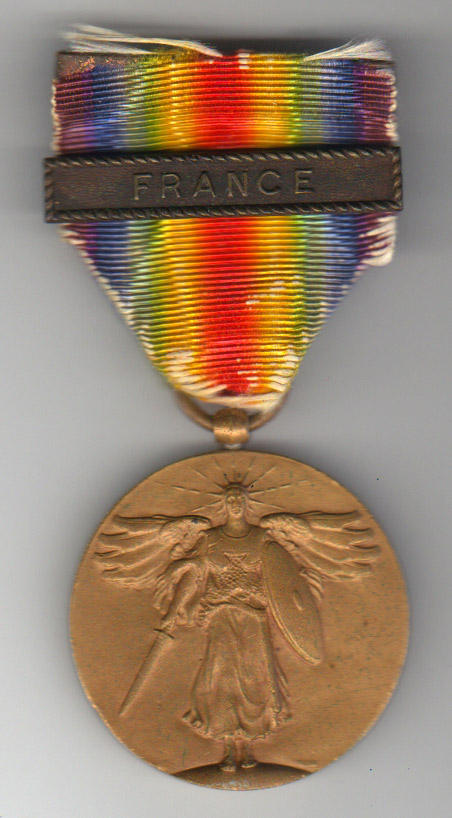 0
0 -
And the Medal of Military Merit
Regards,
Rob
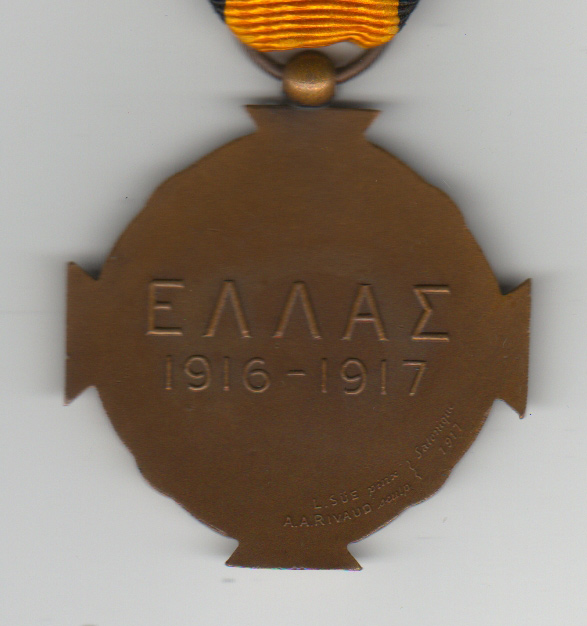 0
0 -
Here is the reverse of the War Cross.
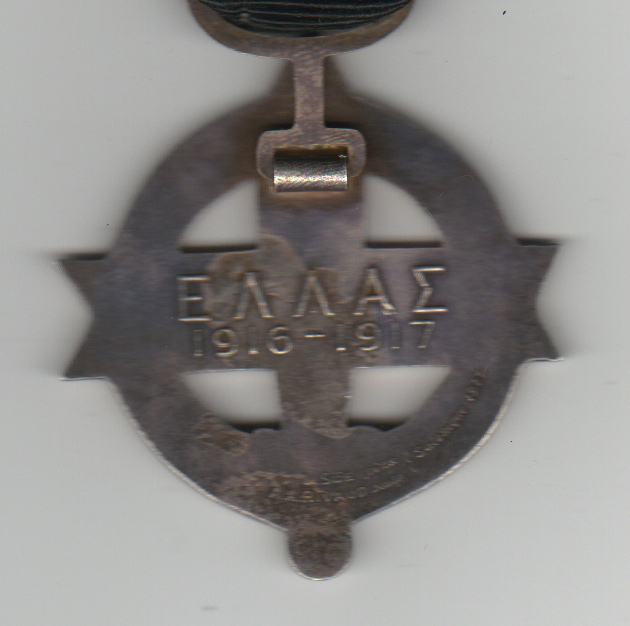 0
0 -
Hi Rob,
These two are very fine pieces. Check the tiny letters on the reverse (at the bottom of the letters), they read "Salonique 1915" and the names of the (French) sculptor and designer.
These are the very first medals to be awarded to Greek and allied troops for WW1 - Salonica Front. There were many variations made by other local or foreign makers afterwards but when you see such pieces, well its the real thing!
Best regards,
Nicholas
Hello Nicholas,
You are correct again. On the reverse of both medals is the marks of:
L.Süe (Sculptor)
A.A.Rivaud (Designer)
Salonique 1917
Pics of the reverse to follow.
Regards,
Rob
0 -
Question:
Did the US Navy issue a France clasp for WW1 US Victory medal? I noticed an Aviation clasp along with a France clasp on a WW1US Victory medal
and wonder if the France was an authorized clasp.
Thanks
Hello Bosungus,
As has been indicated in post #332 the Army service clasps were all eventually authorised for duty ashore in the relevant areas under certain timeframes.
The point that needs to be made is that these country (service) clasps that were authorised for Navy & Marine Corps personnel were of the Army format and hence would be the same as the regular service clasps issued to Army personnel. As the Navy adopted a one clasp only rule, only one such clasp, either Navy format or Army format if qualified, could be worn.
While it is not unusual to see combined Army & Navy clasp combinations this is usually seen in the form of a Navy AVIATION clasp and an Army battle or engagement clasp. While it would not be unusual to see a Navy or Marine Corps medal with an Army service clasp I would suggest that it would be rare as the permission to wear such Army clasps was approved quite a few years after the conclusion of the Great War (First World War). It would be expected that the majority of Navy & Marine Corps personnel would have already been awarded their medal with corresponding Navy clasp so would not have needed to apply for an Army clasp at a much later date.
Of course this does not discount the possibility of a later re-issue or replacement medal being requested that may have had such a combination, or the fact that a veteran simply put the clasps he felt he was entitled to on his medal.
There are numerous other examples of unofficial strikes of Army clasps, in the Navy rope bordered format seen in the market.
Regards,
Rob
0 -
Did you try the OMSA ribbon bank?
Thanks Ulsterman,
I have sent an e-mail request to the Ribbon Bank Manager, so we will see what transpires.
Regards,
Rob
0




Croix du Combattant
in France
Posted
Hello Tim,
Yes I have been to that site before. As you have indicated Arthus Bertrand has a number of marks as did the other major French medal manufacturers of the time.
I am aware that Chobillon, Delande, and Bertrand all had a number of different marks that were used so that makes the identification all the more problematic yet at the same time all the more fun.
Regards,
Rob